Re: Wuhan Coronavirus Resource Thread
Posted: 31 May 2021 16:00
https://www.financialexpress.com/lifest ... t/2260652/
Why is Delhi govt only using covaxin in June?
Why is Delhi govt only using covaxin in June?
Consortium of Indian Defence Websites
https://forums.bharat-rakshak.com/
The article has more than what is mentioned in the post. I will quote themIndraD wrote:Centre looks to finetuning vaccine strategy: studying single-shot effect to mixing doses https://indianexpress.com/article/india ... 7275/lite/
Single dose oxford is bad idea ^
Phe UK prospective study shows only 33% effectiveness w single dose Oxford against B617 (so called Indian) variant of Chinese virus
The Government plans to review the impact of its decision to extend the interval between Covishield doses once it collects data from a newly proposed Covid vaccine tracker platform that it will launch shortly, The Indian Express has learnt. The data, sources said, may also help the Government decide whether to approve a single-dose regimen for Covishield.
The data from the new platform is expected to be analysed around August, sources said.
Important to understandA platform is being established where three sets of administrative data in terms of diagnostic data, vaccine data and the overall disease data are to be harmonised. Based on that, we will look at vaccine effectiveness, reinfections and trends as vaccine coverage increases,” Dr N K Arora, chairman of the Covid working group under the National Technical Advisory Group on Immunisation (NTAGI), said.
why we need to stduy moreDiscussions on the need to study the effectiveness of Covid vaccines began in March-April, according to Arora. Before this, India had not been tracking the effectiveness of vaccines it was administering in a real-world situation.
This help the people who are vaccine skeptics or those who believe vaccines dont workThe idea is to study aspects like breakthrough infections following vaccinations and the severity of infections post-immunisation. “This will give an idea of how long you are likely to be protected from the disease after immunisation… It will also tell us the impact of increasing the interval between doses on vaccine efficacy and whether there is a need for modification either by increasing or decreasing the interval,” Arora said, adding that the data will be reviewed “two to three months later”.
Another aim of the review is to understand whether a single dose is effective, a source close to the development told The Indian Express on condition of anonymity. “An argument being placed is that other viral vector vaccines have single-dose versions, and this might work for Covishield too, which started out as a single-dose vaccine,” the source said.
Real practical situation in India and also the worldA single-dose regimen would help the Government cover the population faster with its vaccination drive, which has slowed down due to a shortage.
Good intergration of available platforms.The vaccine-tracking platform is expected to work using existing platforms developed by the Centre to track Covid cases and vaccinations. This includes the use of the RT-PCR and Aarogya Setu app, which has collected data on testing and confirmation of cases, and the CoWIN platform created to help people register, book and receive certificates for vaccinations.
“As new ideas come up, as the thinking process becomes sharper, and as a better understanding of the progression of the disease develops, such strategies become clearer and processes have been put into practice,” he said.
According to him, the effort is to make this a “permanent” platform that can be used for other new and emerging diseases that require vaccinations in the future.
https://twitter.com/SuchitraElla/status ... 8400906246IndraD wrote:https://www.financialexpress.com/lifest ... t/2260652/
Why is Delhi govt only using covaxin in June?
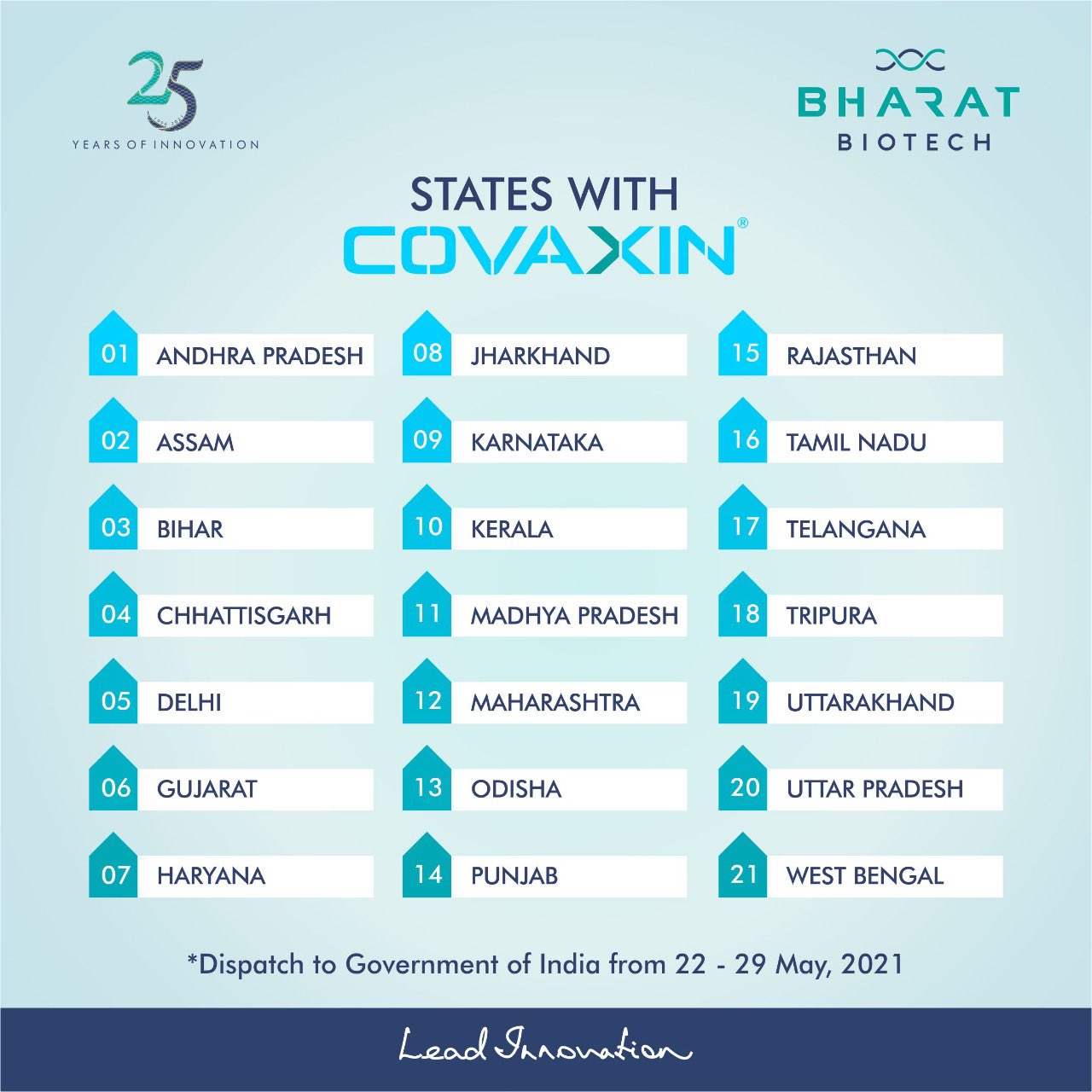
More than nine in 10 UK adults have antibodies to SARS-CoV-2 following one dose of the Oxford AstraZeneca or Pfizer BioNTech vaccine, while almost everyone does after a second dose, preliminary data suggest.1
A study of 8517 adults in England and Wales by University College London’s Virus Watch project found that 96.42% (95% confidence interval 96 to 96.79) of people who had either vaccine had developed antibodies 28 to 34 days after their first dose, rising to 99.08% (95% CI 97.8 to 99.62) within seven to 14 days of the second dose.
Seropositivity rates and spike antibody levels rose more quickly following the first dose of the Pfizer vaccine (89.27% (95% CI 83.52 to 93.25) than for AstraZeneca (66.27% (95% CI 2.56 to 69.80) at 14 to 20 days, but were equivalent for both vaccines by 4 weeks (96.17% (95% CI 94.22 to 97.50) v 95.21% (95% CI 93.75 to 96.35)). ( pfizer vaccines had faster antibody levels relatively only)
“Our data indicate very high rates of seroconversion to spike following a single dose of either vaccine, with near complete seroconversion following a second dose, in people with no evidence of prior infection,” said the UCL research team led by Maddie Shrotri.
(important data to know )Participants provided blood samples and self-reported vaccination status. None had antibodies before receiving a first dose.
IOW people with old age, chronic diseases and cancers with treatment had some issues. This is not unusual but expected.After a single dose, there was evidence to suggest a significant difference in antibody levels by age group at ≥28 days (P=0.0001), with levels lower in older people (18 to 34y, median 63.4 U/ml (IQR 34.2 to 99.34) v ≥80y, 26.13 (8.34 to 80.4) (P=0.0001)).
In 65 to 79 year olds who had had only one dose, lower antibody levels were observed in men (25.9 v 42.3 U/ml, P<0.0001), people with a chronic condition (33.0 v 41.2 U/ml, P<0.0001), diabetes (22.32 v 36.01 U/ml, P<0.0001), cardiovascular disease (32.1 v 36.7 U/ml, P=0.0002), or those history of cancer (30.1 v 35.7 U/ml, P=0.0001), particularly those with haematological rather than solid organ cancer (7.48 v 31.68 U/ml, P<0.0001), and those currently on immunosuppressive therapy (21.7 v 35.6 U/ml, P<0.0001).
But disparities did not persist after a second dose, with high antibody titres (≥250U/ml) observed for nearly all people across all ages, demographics, and clinical groups.
Thanks, this is the sort of information the original post should have contained. If someone just says 'people are dying despite vaccination', then you are feeding vaccine hesitancy. It's important for clear data on these cases to be available, because a lot of hesitancy is driven by unbacked anecdotes on WhatsApp. How you present the information makes a huge difference to whether the information constitutes actionable data, or whether its simply more scaremongering on SM.Thakur_B wrote:Suraj ji, most of the test centres are not feeding vaccination status in RTPCR test data, which has led to data being incomplete.
Be rest assured I am not feeding "heard it from someone cases". Here is a summary of cases in family and friends.
Case 1 - Neighbour, Male 75, comorbidities - Coronary Heart Disease - Vaccine status both shots of Covishield with 4 week gap - Infection after 2 weeks of second dose - deceased
Case 2 - Doctor, Male around 50, Comorbidities - None, Vaccine status - both doses of covishield, infection about a month after second dose - deceased
Case 3 - both of my Parents, Age 67/70, Comorbidities - father has mild Asthma, vaccine status - both doses of covishield with 4 week interval - infection two weeks after second dose - recovered without any issues.
Case 4 - FIL, Age 73, Comorbidities - Mild hypertension, vaccine status - single dose of covishield, Infection - 3 weeks after first dose - recovered with oxygen support
Case 5 - Cousin, Age 55, comorbidities - none, vaccine status, single dose of covishield, infection - 4 weeks after first dose - recovered after oxygen and ventilator support.
Case 6 - Colleagues mother, Age 77, comorbidities - coronary heart diseases, infection - 5 weeks after first dose, required oxygen and ventilator support - deceased.
So yes Suraj ji, break through cases are not rare. Hospitalisation after vaccination is also not rare. These are just cases in immediate friends and family.
Also, it is my request to not treat this kind of information as anti-vaxx propaganda or FUD. Probably all these cases of break through were indeed rare, but till data gets consolidated, we should be vary.
There are stories in news media.Simply phenomenal! - researchers at IIT HYDERABAD have developed oral tablets of #AmphotericinB to treat post #COVID19 fungal infections.
Funded by Department of Science and Technology, Government of India's Nanomission, the team has kept tech free of IP rights to enable quick mass production of the drug, once approved.
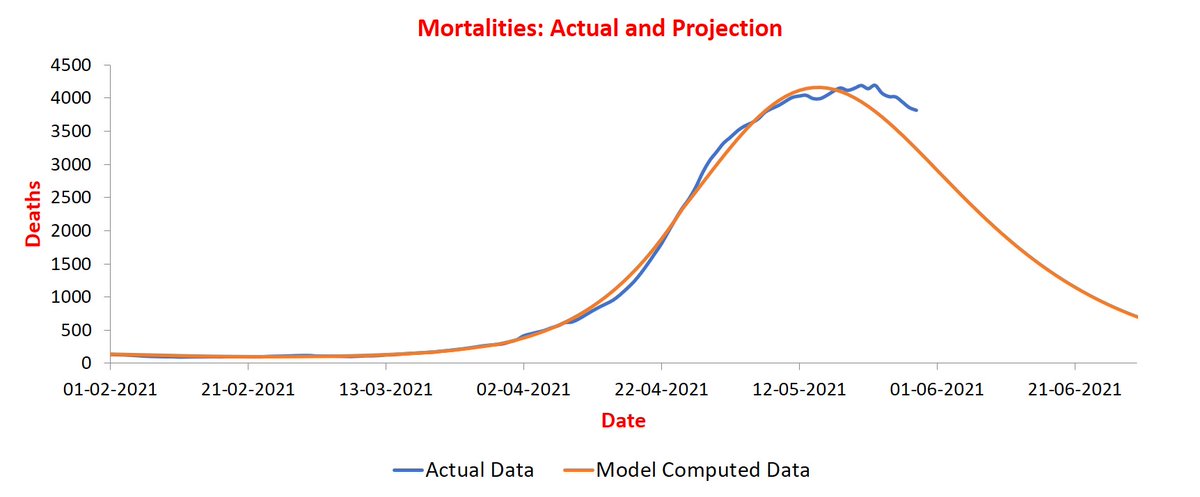
Since there were no PIB numbers reported yesterday (Sunday), I am applying Suraj San's formulate the total difference for two days from last reported numbers on Saturday:Cumulative Vaccine Coverage exceeds 21.58 Crore
More than 2.02 Cr beneficiaries of age group 18-44 Vaccinated so far
More than 25 lakh Vaccine Doses administered today till 7 pm
The cumulative number of COVID-19 vaccine doses administered in the country exceeded 21.58 Cr (21,58,18,547) as per the 7 pm provisional report today.
12,23,596 beneficiaries of the age group 18-44 years received their first dose and 13,402 beneficiaries of the same age group received their second dose of COVID vaccine today. Cumulatively, 2,02,10,889 persons across 37 States/UTs have received their first dose and total 23,491 have received their second dose since the start of Phase-3 of the vaccination drive. Bihar, Delhi, Gujarat, Haryana, Karnataka, Madhya Pradesh, Maharashtra, Rajasthan, Tamil Nadu, Uttar Pradesh and West Bengal have administered more than 10 lakh beneficiaries of the age group 18-44 years for the first dose of COVID vaccine.
The total of 21,58,18,547 include 98,83,778 Healthcare Workers (HCWs) who have taken the 1st dose and 67,87,633 HCWs who have taken the 2nd dose, 1,56,67,311 Frontline Workers (FLWs) (1st dose), 85,21,965 FLWs (2nd dose), 2,02,10,889 for 18-44 years of age group (1st dose) and 23,491 for 18-44 years of age group (2nd dose). 6,64,02,012 for over 45 years old to 60 years old (1st Dose), 1,07,15,693 for over 45 years old to 60 years old (2nd dose), 5,88,31,736 for above 60 years (1st Dose) and 1,87,74,039 for above 60 years (2nd Dose).
As on Day-136 of the vaccination drive (31st May, 2021), total 25,52,501 vaccine doses were given. 22,75,324 beneficiaries were vaccinated for 1st dose and 2,77,177 beneficiaries received 2nd dose of vaccine as per the provisional report till 7 P.M.
Seeking fast-track approvals to bring Moderna's single-dose COVID-19 booster vaccine in India expeditiously, Cipla has requested the government for indemnification and exemptions from price capping, bridging trials and basic customs duty, while stating that it is close to committing over USD 1-billion as advance to the US major, sources said on Monday.
Requesting the government to provide confirmation on four critical points --- exemption from price restriction, indemnification, bridging trial waiver and basic customs duty exemption, Cipla has said such an assurance will help make this significant financial commitment of more than USD 1 billion (over Rs 7,250 crore) advance to Moderna for its booster vaccine in India, sources privy to the development said.
Cipla's latest communication to the government, dated May 29, follows a high-level meeting held recently during which it was discussed that Moderna has proposed to launch a single-dose vaccine for the Indian market, for which, they were in discussion with Cipla and other Indian companies.
It was also discussed in that meeting that orders for supply of the vaccine in 2022 may be placed with Moderna expeditiously and that Cipla has evinced interest to procure 50 million doses from Moderna for 2022.
Seeking exemption from price restriction, Cipla said, "Given the size of the population we need to immunize with boosters, it is our avid belief that the government and private players can work together to deliver the vaccination programme, best serving the public interest."
"Any restriction brought on pricing may dissuade the mRNA players from providing their vaccines in India, considering the serious competing demand by other countries chasing the limited supply of vaccines," a source quoted Cipla as having communicated to the Indian government.
The company has further requested for the government's assurance that no price capping would apply for imported vaccines to be provided through private hospitals and that the booster vaccine can be covered under the liberalised pricing policy and kept exempt from any price capping.
Saturday - 3MKakkaji wrote:Today's official vaccination numbers from PIB:
COVID-19 Vaccination Update- Day 136
Since there were no PIB numbers reported yesterday (Sunday), I am applying Suraj San's formulate the total difference for two days from last reported numbers on Saturday:Cumulative Vaccine Coverage exceeds 21.58 Crore
More than 2.02 Cr beneficiaries of age group 18-44 Vaccinated so far
More than 25 lakh Vaccine Doses administered today till 7 pm
The cumulative number of COVID-19 vaccine doses administered in the country exceeded 21.58 Cr (21,58,18,547) as per the 7 pm provisional report today.
12,23,596 beneficiaries of the age group 18-44 years received their first dose and 13,402 beneficiaries of the same age group received their second dose of COVID vaccine today. Cumulatively, 2,02,10,889 persons across 37 States/UTs have received their first dose and total 23,491 have received their second dose since the start of Phase-3 of the vaccination drive. Bihar, Delhi, Gujarat, Haryana, Karnataka, Madhya Pradesh, Maharashtra, Rajasthan, Tamil Nadu, Uttar Pradesh and West Bengal have administered more than 10 lakh beneficiaries of the age group 18-44 years for the first dose of COVID vaccine.
The total of 21,58,18,547 include 98,83,778 Healthcare Workers (HCWs) who have taken the 1st dose and 67,87,633 HCWs who have taken the 2nd dose, 1,56,67,311 Frontline Workers (FLWs) (1st dose), 85,21,965 FLWs (2nd dose), 2,02,10,889 for 18-44 years of age group (1st dose) and 23,491 for 18-44 years of age group (2nd dose). 6,64,02,012 for over 45 years old to 60 years old (1st Dose), 1,07,15,693 for over 45 years old to 60 years old (2nd dose), 5,88,31,736 for above 60 years (1st Dose) and 1,87,74,039 for above 60 years (2nd Dose).
As on Day-136 of the vaccination drive (31st May, 2021), total 25,52,501 vaccine doses were given. 22,75,324 beneficiaries were vaccinated for 1st dose and 2,77,177 beneficiaries received 2nd dose of vaccine as per the provisional report till 7 P.M.
Cumulative Day 136 (21.58cr) - Day 134 (21.18cr) = 40 lakh doses total over Sunday and Monday.
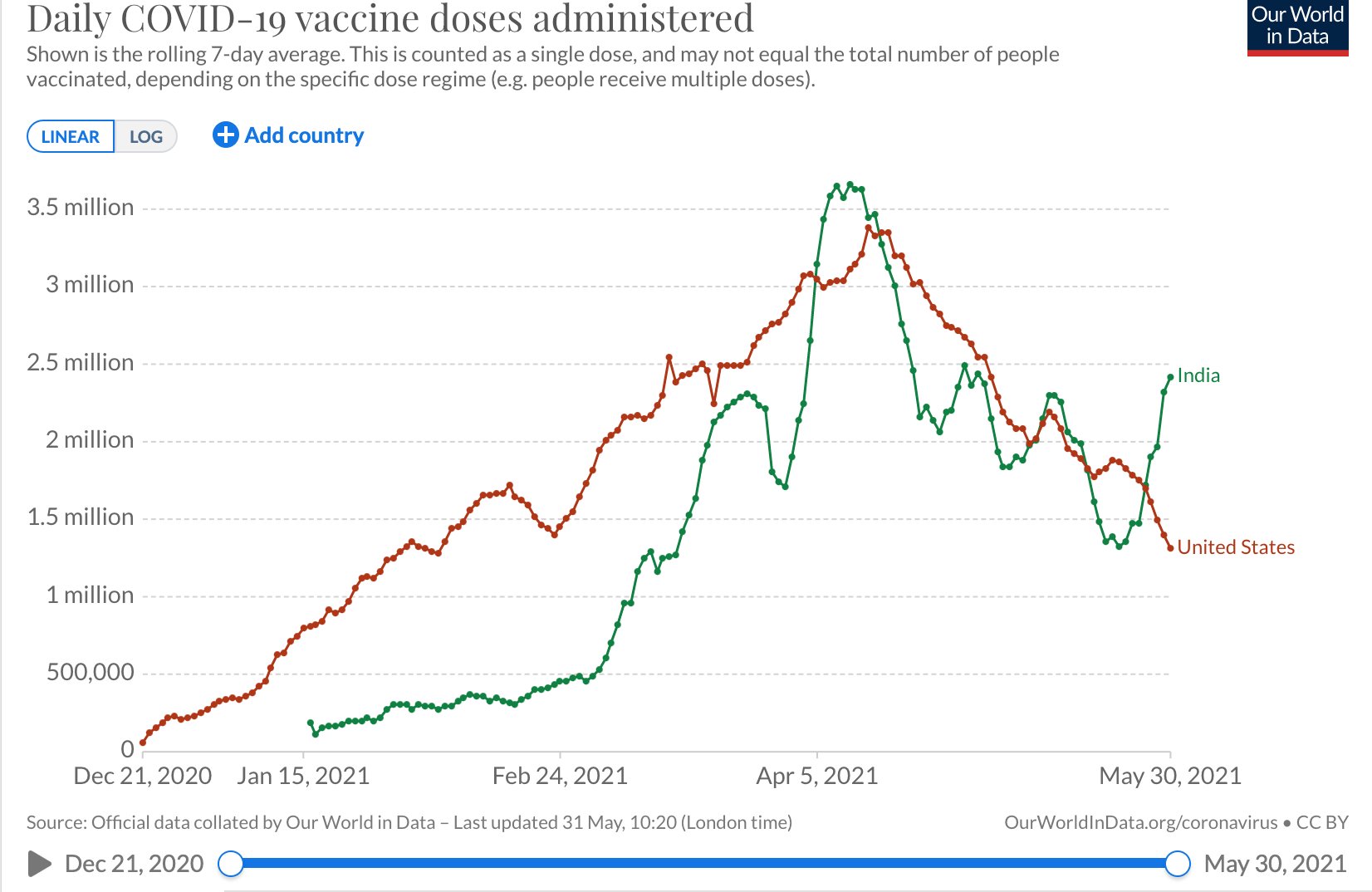
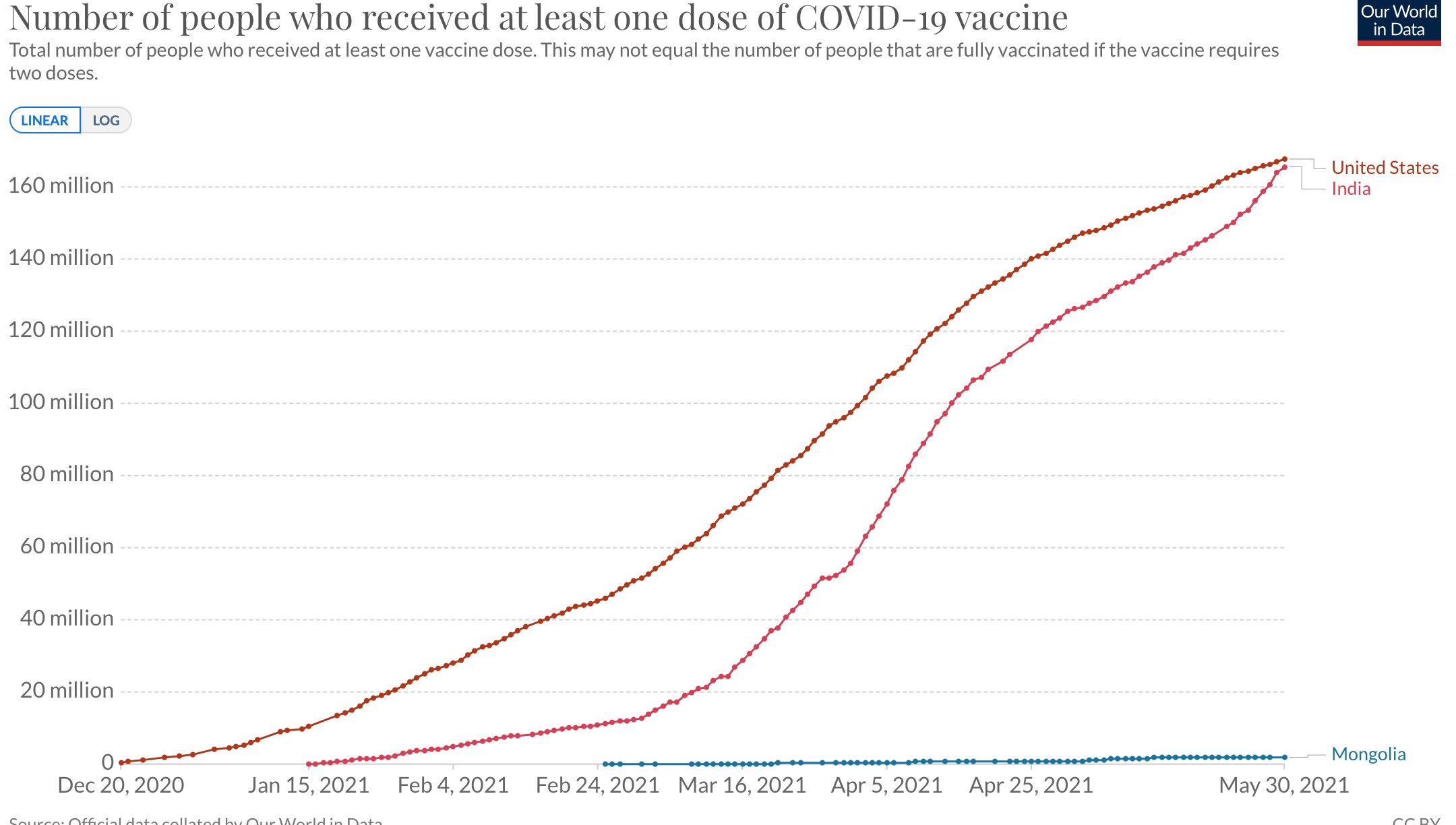
This is what Phase 3 liberalisation was designed to do. That the workers critical to keep the economy going, can get their jabs quickly through their employers. It is picking up momentum now.Delhi Airport: Today, Delhi’s Indira Gandhi International Airport announced the launch of a dedicated vaccination centre for COVID-19 in association with Manipal Hospital, starting from 1 June 2021. The facility set up at Terminal-1 (T-1) of IGI Airport, aims to provide vaccination opportunity to over 60,000 employees of various stakeholders- airlines, ground handling agencies, Air Traffic Control, cargo business, among others, working at the international airport, Delhi International Airport Limited (DIAL) said. All airport employees who are over 18 years of age can register themselves and get jabbed at the vaccination centre on a payment basis, either directly by themselves or through their employer, according to a PTI report.
No use. Test centres do not feed vaccination status. Death certificates do not mention covid, rather ARDS, Cardiac Arrest, Multiple Organ Failure etc. More than a dozen people have died at my workplace due to covid. None had their cause of death listed as Covid. Listing the cause of death as covid opens up possibility of compensating the families as Covid has been notified as a disaster. Insurance companies are chickening out in accounting them as workplace related incident. We are an essential service provider, so working from home was not an option for employees. Our organisation had to resort to making an employee fund to compensate the families of the deceased.Pratyush wrote:The thing with vaccination is that the data is collected using adhar. Therefore, in case of breakthrough infection it will be relatively easy to arrive at the details of the cases relatively easily.
Finally, TN had finally picked up on the vaccination and the earlier stocks are drying out and awaiting fresh supplies.Express News Service
CHENNAI: Tamil Nadu Health Minister Ma Subramanian on Monday said that the state’s COVID-19 vaccine stock will be exhausted in the next two days and it is awaiting more supplies from the central government.
Addressing reporters after inaugurating the second batch of 504 oxygen beds here at the Chennai Trade Centre, Health Minister Ma Subramanian said that the state has five lakh doses of COVID-19 vaccines, which would be exhausted in two days. “We are awaiting the Centre's supply of fresh doses and we hope they will send it soon. Once we get it, we will supply it to all the districts,” the minister said.
The minister said that the central government has given a total of 83 lakh doses and the Tamil Nadu government has procured an additional 13 lakh doses through its orders. “We totally have got 96 lakh doses. We have placed orders worth Rs 85.48 lakh for 25 lakh doses. We have received 13 lakh doses and another 12 lakh are expected to come soon,” the minister added.
ALSO READ: All Chennai Corporation zones see decline in Covid-19 cases
He also said that global tenders for 3.5 crore vaccine doses would be opened on June 5 and the successful bidders will be giving vaccines within six months of bidding. “We have also requested the Centre to either use the Chengalpet vaccination manufacturing plant or hand it over to the state to produce the vaccine. Our MPs in Delhi are directly in talks with central MPs and a decision in this regard is expected soon,” the minister said.
He also responded to the criticism by former Chief Minister Edappadi K Palaniswami who had said that the government was hiding the death numbers. “We have told all district officials not to hide any deaths during our visits to the districts. The Tamil Nadu government has no need to hide any deaths,” he said.
Meanwhile, 203 patients are undergoing treatment for COVID-19 at the Chennai Trade Centre where an additional 504 beds have been added. The Centre now totally has 864 beds, of which 804 are oxygen beds. “Even though COVID-19 is decreasing, the Chief Minister has given instructions to increase the beds,” the minister added.
On Monday, the minister also inaugurated a 120-bed COVID-19 facility which will offer treatment through the practices of yoga and naturopathy.
You and I are talking about different things. I am talking about breakthrough infections and you are talking about deaths.Thakur_B wrote:
No use. Test centres do not feed vaccination status. Death certificates do not mention covid, rather ARDS, Cardiac Arrest, Multiple Organ Failure etc. More than a dozen people have died at my workplace due to covid. None had their cause of death listed as Covid. Listing the cause of death as covid opens up possibility of compensating the families as Covid has been notified as a disaster. Insurance companies are chickening out in accounting them as workplace related incident. We are an essential service provider, so working from home was not an option for employees. Our organisation had to resort to making an employee fund to compensate the families of the deceased.
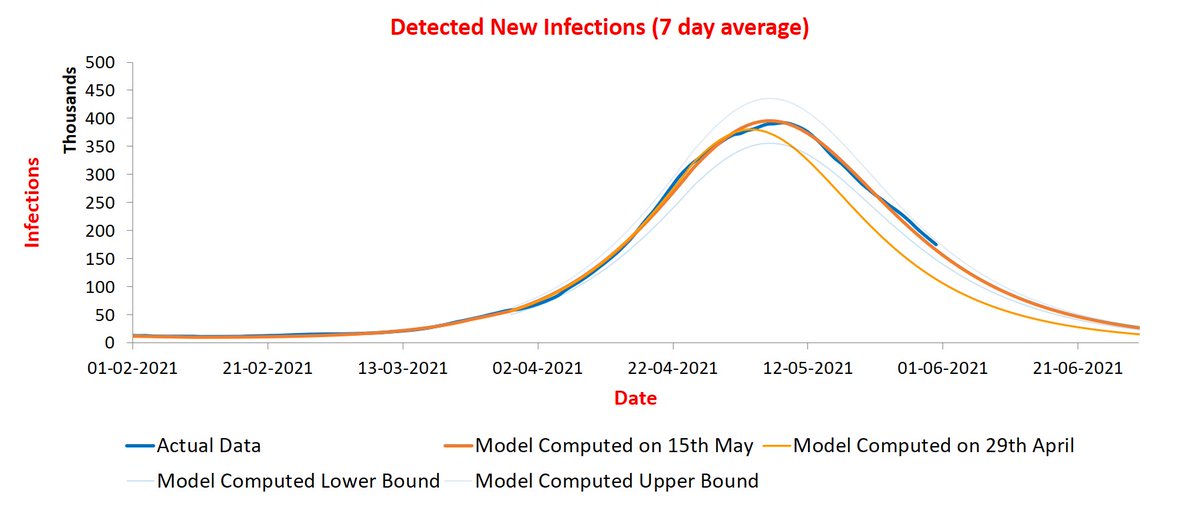
https://twitter.com/Uncommo52204052/sta ... 49632?s=20Debunking claims of 5-10x deaths:
Only during spike-phase, when system lost control, does this absurd claim even need debunking. Even then, it's an extraordinary claim requiring extraordinary evidence. I'll show that evidence presented is far from extraordinary.
In such studies, 'analysts' just throw out absolute numbers (40k excess deaths here, 11k there). To make it meaningful, I calculate excess deaths per month per million population. We can compare across regions/times. We can compare to India's all-cause mortality of 600/month/mn...
The country will be able to vaccinate more than a crore people per day by early to mid July and the entire country will be covered by December, Dr Balram Bhargava, DG, Indian Council of Medical Research, said on Tuesday.
The country is still in the midst of a ferocious second wave of the Covid pandemic and although it is abating because of the containment and testing, the country cannot return to business as usual, Bhargava warned. For opening up a district, test positivity has to be less than 5%, vaccination of 70% of those above 60 years and those above 45 years with comorbidities should be vaccinated, and Covid-appropriate behaviour continues at all levels, Bhargava said.
Unlocking has to done patiently guided by the amount of vaccination that has been done for the vulnerable group, he said. The virus has been just suppressed but it can resurface anytime, he said. Care would have to be taken till such time that 70% of the vulnerable population has been vaccinated or herd immunity is achieved, Bhargava said.
Hyderabad-based Biological E tied up with Calgary-based Providence Therapeutics to manufacture its mRNA technology-based Covid-19 vaccine and do clinical trials in India. The deal assumes significance as this gives India access to the mRNA technology.
The vaccine, named PTX-COVID19-B, is under development in Canada at the moment. Providence announced data from the phase 1 trials in May and will begin the phase 2 trials soon.
“The mRNA platform has emerged as the front runner in delivering the first vaccines for emergency use to combat the COVID-19 pandemic. Biological E. is very pleased to be able to work with Providence on its promising mRNA vaccine candidate. We hope to provide India and other countries yet another option to ramp up their efforts towards achieving herd immunity against COVID-19,” said Mahima Datla, Managing Director of Biological E Limited.
Providence will sell up to 30 mn doses of its mRNA vaccine to Biological E. It would also provide the necessary technology transfer to make the vaccine in India, with a minimum production capacity of 600 mn doses in 2022 and targets capacity of 1 bn doses.
“Biological E will be responsible for all clinical development and regulatory activities for the mRNA vaccine in India and other jurisdictions licensed by Biological E,” the company said.
India already has one mRNA vaccine in development by Pune-based Gennova Biopharmaceuticals which is in phase 1 clinical trials.
Apart from the J&J and Providence Covid-19 vaccine deals, Biological E also has under development a third candidate with Baylor College of Medicine. The Baylor College of Medicine – Biological E vaccine is set to begin phase 3 clinical trials in June. This is a protein sub-unit technology based vaccine, a technology that Biological E already had. This technology is used to make Hepatitis B vaccines.
The Indian government has indicated that in the second half of the year, it expects to receive 300 mn doses of the Biological E vaccine.
India is already in talks with US players Pfizer and Moderna for bringing their USFDA-approved mRNA Covid-19 vaccines to India.
The World Health Organization (WHO) said on Tuesday it has approved a COVID-19 vaccine made by drugmaker Sinovac Biotech for emergency use listing, paving the way for a second Chinese shot to be used in poor countries.
A WHO emergency listing is a signal to national regulators on a product's safety and efficacy. It will also allow the shot to be included in COVAX, the global programme to provide vaccines mainly for poor countries, which faces major supply problems due to an Indian export suspension.
The independent panel of experts said in a statement it recommended Sinovac's vaccine for adults over 18, with a second dose 2-4 weeks later. There was no upper age limit as data suggested it is likely to have a protective effect in older people.
Sinovac said that it had supplied more than 600 million doses of its vaccine at home and abroad as of end-May and over 430 million doses have been administered.
Vaccine efficacy results showed that the vaccine prevented symptomatic disease in 51% of those vaccinated and prevented severe COVID-19 and hospitalisation in 100% of the studied population, the WHO said.
The WHO's separate Strategic Advisory Group of Experts (SAGE) had said previously in a review document that vaccine efficacy in multi-country Phase III clinical trials ranged from 51% to 84%.
Indonesia's health ministry said on May 12 that its study of 120,000 healthcare workers who had received the vaccine found it was 94% effective at preventing symptomatic disease.
In a preliminary evaluation, the SAGE panel found that the shot was efficacious in preventing COVID-19 in adults under 60, but that some quality data on the risk of serious adverse effects was lacking.
It cited evidence gaps in safety in pregnancy, and on safety and clinical protection in older adults, those with underlying disease, and evaluation of rare adverse events detected through post-authorization safety monitoring.
The SAGE experts, who issue policy recommendations to states and dosage guidelines, reviewed Sinovac clinical data last month.
22 May, 2021
OpIndia Staff
The wastage rate recorded in Rajasthan's Churu district stood the highest at 39.7 per cent, according to reports.
In Rajasthan 11.5 lakh doses of Covid-19 vaccine wasted
Rajasthan reported the highest percentage of Covid-19 vaccine wastage. According to a report by Hindi daily Patrika, a total of 11.5 lakh doses of Covid-19 vaccine, which amounts to almost 7 per cent, has been wasted in the Congress-ruled state.
Though many districts in Rajasthan have reportedly wasted several doses of vaccines, the wastage rate recorded in Rajasthan’s Churu district stood the highest at 39.7 per cent, followed by Hanumangarh, where the waste per cent was recorded to be 24.60 per cent. Bharatpur stood at number three after it reported 17.13 per cent. Kota finished fourth with a 16.71 per cent of waste rate.
Congress runs a sinister anti-vaccine campaign
For the past few months, non-NDA parties, especially Congress and AAP have been playing petty politics over the Central government’s vaccination drive.
Congress, which has been persistently trying to milk the Covid-19 crisis to tarnish the image of the BJP government, has been running a sinister campaign against Indian vaccine makers while campaigning for much more costly vaccines made by foreign companies. One of the strategies employed by them was discrediting the indigenous Covaxin vaccine, developed by Bharat Biotech. The government had approved its emergency use in the month of January.
Using this as the primary tool for propaganda, Congress leaders such as Shashi Tharoor, Manish Tewari, and Chhattisgarh health Minister TS Singh Deo trivialised the vaccination drive altogether. And, obviously, in all this, the leftist media has stood shoulder to shoulder with the Congress party, helping in accentuating the panic and vaccine hesitancy among people.
Hard to understand that article.Suraj wrote:Please avoid throwing anecdotes around. The topic is controversial as it is, and anecdotes offer no actionable information. Here's an example of an evidence-based analysis of the topic:
An Evidence-Based Estimation Of Covid Deaths That Is Far Better Than NYT’s